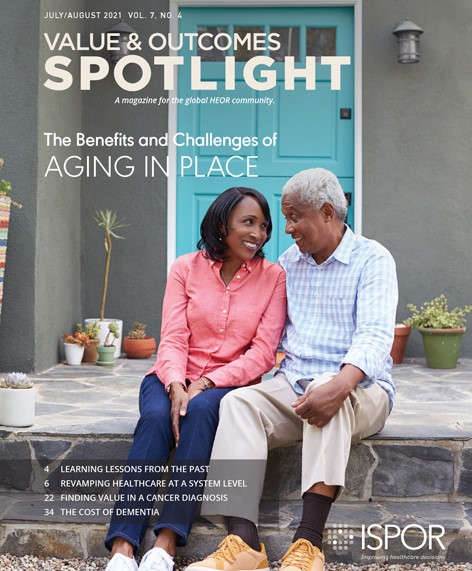Living Longer, Healthier Lives in Limited Resource Settings
Section Editors: Soraya Azmi, MBBS, MPH, Beigene, USA; Agnes Benedict, MSc, MA, Evidera, Budapest, Hungary
Guest Contributor: Louise Parmenter PhD, MSc, IQVIA, Reading, UK
Predictors of Health-Related Quality of Life Status Among Elderly Patients With Cardiovascular Diseases
Saqlain M, Riaz A, Ahmed AA, Kamran S, Bilal A, Ali H
Value Health Reg Issues. 2021; 24(C):130–140
Quality of life is an important patient-reported outcome in the care of older patients with chronic diseases owing to aging-associated limited physical activity and poor health status. The paper by Saqlain et al helps us to evaluate health-related quality of life (HRQoL), its predictors, and association with physical function among elderly cardiac outpatients in Islamabad, Pakistan. Here, healthcare resources are limited, and cardiovascular disease poses a challenging health concern, accounting for 19% of disease in those aged 65 years and older. This population has multiple manifestations of cardiovascular disease and most of the medications prescribed to treat their cardiovascular diseases are taken for a long period of time. To the best of the author’s knowledge, this is the first study that assesses the HRQoL status among older cardiac patients in Pakistan. It is important to address the paucity of data concerning HRQoL in the older cardiac population in settings with low healthcare provision.
Health systems around the world are focusing on longer, healthier lives. Quality of life is imparted by a person’s function and health status. Functional and health status become more dominant predictors of quality of life as we age. Health status measured by self-administered tools such as the HRQoL questionnaire provides a powerful forecaster of morbidity and mortality.
Physical function is often considered an important predictor of quality of life in the geriatric population. The physical functioning capacity of older individuals is frequently estimated by measuring their ability to perform activities of daily living. Activities of daily living can be defined as common everyday tasks that are required for maintaining an independent life or that are necessary for survival.
A descriptive, nonexperimental, cross-sectional study was carried out from May 2018 to October 2018 in the outpatient departments of a tertiary-care hospital. The population under study were patients aged >65 years with at least 1 cardiovascular condition. The EQ-5D-3L (Euro QOL) and Barthel index were used to measure the quality of life and performance of activities of daily living, respectively. The EQ-5D health questionnaire provides a simple descriptive profile and a single index value for health status. It measures the 5 dimensions of (1) mobility, (2) self-care, (3) usual activities, (4) pain/discomfort, and (5) anxiety/depression. The Barthel Index consists of 10 items that measure a person’s daily functioning, particularly the activities of daily living and mobility. The items include feeding, transfers from bed to wheelchair and to and from a toilet, grooming, walking on a level surface, going up and down stairs, dressing, and continence of bowels and bladder.
A total of 386 patients were admitted during the study period, of which 52% (n = 201 of 386) were female and 80.1% (n = 309/386) were in the age group of 65 to 74 years. More than half (n = 233, 60.4%) of the patients were receiving polypharmacy (5-9 medications), and 11.6% (n = 46) were taking 9 or more drugs (excessive polypharmacy). According to Barthel index scoring, 70.5% (n = 272) of respondents were independent in performing daily living activities. Most contributors were educated to primary level (30.3%) or had no education (44.3%) and were low (44.8%) or middle (40.4%) income providing a valuable insight into an under-studied population.
Mann-Whitney tests and Kruskal-Wallis tests are nonparametric methods that were used to determine the difference in the quality of life by the sample characteristics. Over half of the patients, 198 (51.3%) reported impairment in the mobility domain, and 272 patients (70.5%) indicated impairment in the depression domain. Mann-Whitney tests revealed EQ-5D scores and visual analogue scale scores significantly differed by the number of hospital admissions (P = .001), fall history (P < 0.001), and ADLs (P < .001). Kruskal-Wallis analysis revealed that EQ-5D index value and visual analogue scale score were significantly lower among patients who had comorbidities and who were exposed to polypharmacy (5-9 medications) (P < .001). In multivariate linear regression analysis, self-reported health (P = .006) and performance of activities of daily living (P < .001) were reported as influencing factors on health-related quality of life.
The paper could be an interesting read for anyone wishing to broaden their knowledge of the use of real-world evidence in healthcare settings with limited resources. Here, diseases often associated with high-income countries are having profound impacts. It goes beyond safety and effectiveness to illustrate where a better understanding of quality of life could support actions to improve many lives. Findings indicated poor quality of life, especially in the depression and pain/discomfort domains, among older patients with cardiovascular disease or heart diseases. Most respondents were low income, illiterate, unemployed, and with comorbid conditions and taking multiple medications.
Pakistan is a developing country with an increased burden of a geriatric population and a poor healthcare system with no special life assistance programs from the government, which made this population more prone to dilemmas that ultimately lead to poor quality of life. The authors suggest that measures should be taken to improve patients’ perception and to enhance awareness regarding the importance of doing daily living activities as a predictor of good quality of life. The underlying structural problems will be harder to solve.

